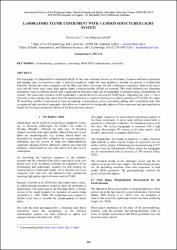Laboratory flume experiment with a coded structured light system
Künye
Akça, M. D. & Seybold, H. (2012). Laboratory flume experiment with a coded structured light system. International Archives of the Photogrammetry, Remote Sensing and Spatial Information Sciences - ISPRS Archives, 39-B5, 399-404.Özet
The topography of inland deltas is influenced chiefly by the water-sediment balance in distributary channels and local evaporation and seepage rates. In a previous study, a reduced complexity model has been applied to simulate the process of inland delta formation. Results have been compared with the Okavango Delta, Botswana and with a laboratory experiment. Both in the macro scale and the micro scale cases, high quality digital elevation models (DEM) are essential. This work elaborates the laboratory experiment where an artificial inland delta is generated on laboratory scale and its topography is measured using a Breuckmann 3D scanner. The space-time evolution of the inland delta is monitored in the consecutive DEM layers. Regarding the 1.0m x 1.0m x 0.3m size of the working area, better than 100 micron precision is achieved which gives a relative precision of 1/10 000. The entire 3D modelling workflow is presented in terms of scanning, co-registration, surface generation, editing, and visualization steps. The co-registered high resolution topographic data allows us to analyse the stratigraphy patterns of the experiment and gain quantitative insight into the spatio-temporal evolution of the delta formation process.


















